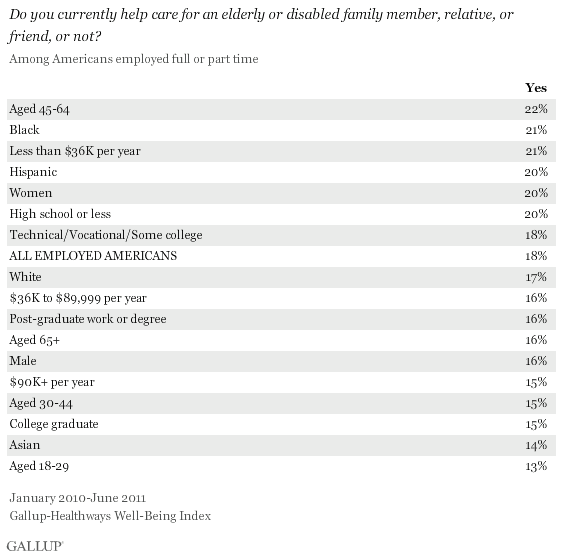This is the first in a special series of in-depth articles on what it means to be a working caregiver in the United States. Part two will reveal the impact of caregiving on the workplace, including the cost of lost productivity. Part three will look at how caregivers report spending their time and specifics of who they are caring for.
WASHINGTON, D.C. -- More than one in six Americans who work a full- or part-time job also report assisting with care for an elderly or disabled family member, relative, or friend.
|
|
Caregivers in the U.S. are diverse, with between 13% and 22% of American workers across major socioeconomic and demographic groups reporting that they fulfill a caregiver role.
These findings are from more than 200,000 surveys of employed Americans collected from January 2010 through June 2011 as part of the Gallup-Healthways Well-Being Index.
The 22% of middle-aged American workers who report being a caregiver is the highest of any group. The 13% of 18- to 29-year-olds who report the same is the lowest percentage across the various groups.
Blacks (21%) and Hispanics (20%) are also among the most likely to act as caregivers. Seventeen percent of white workers say they are caregivers.
Additionally, the lower income and less educated an American is, the more likely he or she is to be a caregiver. Twenty-one percent of Americans with an annual income of less than $36,000 report that they are caregivers compared with 15% of high-income ($90,000 or more per year) households. Similarly, 20% of Americans with a high school education or less fulfill a caregiver role versus 15% of college graduates and 16% of postgraduates.
The relatively lower percentages of high-income and highly-educated American caregivers may be a reflection of their ability to pay for professional care instead of having to fulfill the role themselves. Alternatively, the pattern may be due, at least in part, to those with higher incomes and higher levels of education tending to be younger.
Women are also slightly more likely than men to be caregivers -- 20% versus 16%, respectively.
Caregiving even affects seniors, with 16% of those aged 65 or older reporting they help care for an elderly or disabled family member, relative, or friend.
Bottom Line
More than 1 in 10 American workers in all major demographic and socioeconomic groups report that they are a caregiver. Caregiving is most prevalent among those who are middle-aged, low-income, black, Hispanic, or less educated.
Previous Gallup research has also already shown that caregivers have worse emotional and physical health compared to non-caregivers.
The next article in Gallup's series will show that caregiving also involves a significant investment of time and has a large impact on the workplace.
Community and employer support for the groups most likely to be fulfilling the role of caregiver in addition to their regular employment is likely to go a long way in improving the lives of not just those giving care, but also the lives of the people they care for.
Survey Methods
Results are based on telephone interviews conducted as part of the Gallup Healthways Well-Being Index survey Jan. 2, 2010-June 30, 2011, with a random sample of 239,639 aged 18 and older, living in all 50 U.S. states and the District of Columbia selected using random-digit-dial sampling.
For results based on the total sample of national adults, one can say with 95% confidence that the maximum margin of sampling error is ±1 percentage point.
Interviews are conducted with respondents on landline telephones and cellular phones, with interviews conducted in Spanish for respondents who are primarily Spanish speaking. Each daily sample includes a minimum quota of 150 cell phone respondents and 850 landline respondents, with additional minimum quotas among landline respondents for gender within region. Landline respondents are chosen at random within each household on the basis of which member had the most recent birthday.
Samples are weighted by gender, age, race, Hispanic ethnicity, education, region, adults in the household, cell phone-only status, cell phone-mostly status, and phone lines. Demographic weighting targets are based on the March 2009 Current Population Survey figures for the aged 18 and older non-institutionalized population living in U.S. telephone households. All reported margins of sampling error include the computed design effects for weighting and sample design.
In addition to sampling error, question wording and practical difficulties in conducting surveys can introduce error or bias into the findings of public opinion polls.
For more details on Gallup's polling methodology, visit www.gallup.com/.


